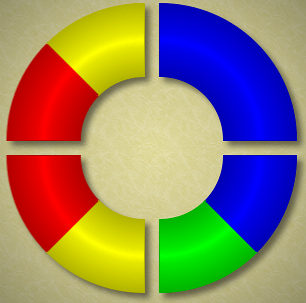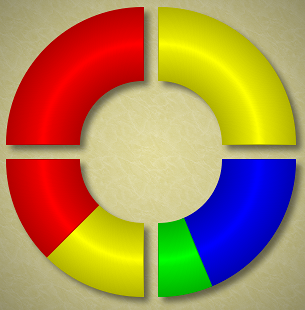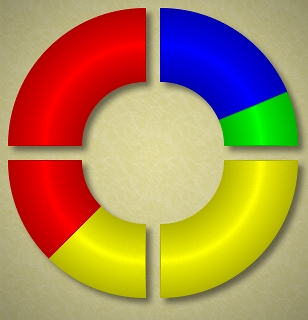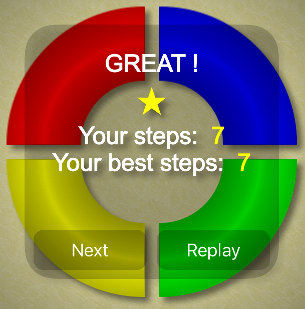Archive for the ‘Puzzles’ Category.
Geometry Puzzles from the 35-th Lomonosov Tournament
Problem 1. It is true that it is possible to put positive numbers at the vertices of a triangle so that the sum of two numbers at the ends of each side is equal to the length of the side?
This looks like a simple linear algebra question with three variables and three equations. But it has a pretty geometrical solution. What is it?
Problem 2. Prove that it is possible to assign a number to every edge of a tetrahedron so that the sum of the three numbers on the edges of every face is equal to the area of the face.
Again we have six sides and four faces. There should be many solutions. Can you find a geometric one?
Share:Who is Guilty?
I am running a PRIMES-STEP program for middle school students, where we try to do research in mathematics. In the fall of 2015 we decided to study the following topic in logic.
Suppose there is an island where the following four types of people live:
- Absolute truth-tellers always tell the truth.
- Partial truth-tellers tell the truth with one exception: if they are guilty, they will say that they are innocent.
- Absolute liars always lie.
- Responsible liars lie with one exception: if they are guilty, they will say that they are guilty.
See if you can solve this simple logic puzzle about people on this island.
It is known that exactly one person stole an expensive painting from an apartment. It is also known that only Alice or Bob could have done it. Here are their statements:
Alice: I am guilty. Bob is a truth-teller.
Bob: I am guilty. Alice stole it. Alice is the same type as me.
Who stole the painting and what types are Alice and Bob?
My students and I discovered a lot of interesting things about these four types of people and wrote a paper: Who Is Guilty?. This paper contains 11 cute logic puzzles designed by each of my 11 students.
I envied my students and decided to create two puzzles of my own. You have already solved the one above, so here is another, more difficult, puzzle:
Share:A bank was robbed and a witness said that there was exactly one person who committed the robbery. Three suspects were apprehended. No one else could have participated in the robbery.
Alice: I am innocent. Bob committed the crime. Bob is a truth-teller.
Bob: I am innocent. Alice is guilty. Carol is a different type than me.
Carol: I am innocent. Alice is guilty.
Who robbed the bank and what types are the suspects?
A Travel Puzzle
The following cute puzzle of unknown origins was sent to me by Martina Balagovic and Vincent van der Noort:
Share:A car travels from A to B and back again. When going uphill it goes 56 km an hour, when going downhill it goes 72 km an hour and while driving on flat surface it goes 63 km an hour. Getting from A to B takes 4 hours and getting back (over the same road) takes 4 hours and 40 minutes.
What is the distance between A and B?
A River-Crossing Puzzle
I have solved too many puzzles in my life. When I see a new one, my solution is always the intended one. But my students invent other ideas from time to time and teach me to think creatively. For example, I gave them this puzzle:
Two boys wish to cross a river, but there is a single boat that can take only one boy at a time. The boat cannot return on its own; there are no ropes or similar tricks; yet both boys manage to cross the river. How?
Here is what my inventive students came up with:
- There was another person on the other side of the river who brought the boat back.
- There was a bridge.
- The boys can swim.
- They just wanted to cross the river and come back, so they did it in turns.
And here is my standard solution: They started on different sides of the river.
I gave a talk about thinking inside and outside the box at the Gathering for Gardner conference. I mentioned this puzzle and the inventiveness of my students. After the conference a guy approached me with another answer which is now my favorite:
- They wait until the river freezes over and walk to the other side.
The Battle I am Losing
I want the world to be a better place. My contribution is teaching people to think. People who think make better decisions, whether they want to buy a house or vote for a president.
When I started my blog, I posted a lot of puzzles. I was passionate about not posting solutions. I do want people to think, not just consume puzzles. Regrettably, I feel a great push to post solutions. My readers ask about the answers, because they are accustomed to the other websites providing them.
I remember I once bought a metal brainteaser that needed untangling. The solution wasn’t included. Instead, there was a postcard that I needed to sign and send to get a solution. The text that needed my signature was, “I am an idiot. I can’t solve this puzzle.” I struggled with the puzzle for a while, but there was no way I would have signed such a postcard, so I solved it. In a long run I am glad that the brainteaser didn’t provide a solution.
That was a long time ago. Now I can just go on YouTube, where people post solutions to all possible puzzles.
I am not the only one who tries to encourage people to solve puzzles for themselves. Many Internet puzzle pages do not have solutions on the same page as the puzzle. They have a link to a solution. Although it is easy to access the solution, this separation between the puzzle and its solution is an encouragement to think first.
But the times are changing. My biggest newest disappointment is TED-Ed. They have videos with all my favorite puzzles, where you do not need to click to get to the solution. You need to click to STOP the solution from being fed to you. Their video Can you solve the prisoner hat riddle? uses my favorite hat puzzle. (To my knowledge, this puzzle first appeared at the 23-rd All-Russian Mathematical Olympiad in 1997.) Here is the standard version that I like:
A sultan decides to give 100 of his sages a test. He has the sages stand in line, one behind the other, so that the last person in line can see everyone else. The sultan puts either a black or a white hat on each sage. The sages can only see the colors of the hats on all the people in front of them. Then, in any order they want, each sage guesses the color of the hat on his own head. Each hears all previously made guesses, but other than that, the sages cannot speak. Each person who guesses the color wrong will have his head chopped off. The ones who guess correctly go free. The rules of the test are given to them one day before the test, at which point they have a chance to agree on a strategy that will minimize the number of people who die during this test. What should that strategy be?
The video is beautifully done, but sadly the puzzle is dumbed down in two ways. First, they explicitly say that it is possible for all but one person to guess the color and second, that people should start talking from the back of the line. I remember in the past I would give this puzzle to my students and they would initially estimate that half of the people would die. Their eyes would light up when they realized that it’s possible to save way more than half the people. They have another aha! moment when they discover that the sages should start talking from the back to the front. This way each person sees or hears everyone else before announcing their own color. Finally, my students would think about parity, and voilà, they would solve the puzzle.
In the simplified adapted video, there are no longer any discoveries. There is no joy. People consume the solution, without realizing why this puzzle is beautiful and counterintuitive.
Nowadays, I come to class and give a puzzle, but everyone has already heard the puzzle with its solution. How can I train my students to think?
Share:A Frog Puzzle
I stumbled upon a TED-Ed video with a frog puzzle:
You’re stranded in a rainforest, and you’ve eaten a poisonous mushroom. To save your life, you need an antidote excreted by a certain species of frog. Unfortunately, only the female of the species produces the antidote. The male and female frogs occur in equal numbers and look identical. There is no way to distinguish between them except that the male has a distinctive croak. To your left you spot a frog on a tree stump. You hear a croak from a clearing in the opposite direction, where you see two frogs. You can’t tell which one made the sound. You feel yourself starting to lose consciousness, and you realize that you only have time to run in one direction. Which way should you go: to the clearing and lick both frogs or to the tree stump and lick the stump frog?
My first thought was that male frogs croak to attract female frogs. That means the second frog in the clearing is probably an already-attracted female. The fact that the stump frog is not moving means it is male. I was wrong. This puzzle didn’t assume any knowledge of biology. The puzzle assumes that each frog’s gender is independent from other frogs. Thus this puzzle is similar to two-children puzzles that I wrote so much about. I not only blogged about this, but also wrote a paper: Martin Gardner’s Mistake.
As in two-children puzzles, the solution depends on why the frog croaked. It is easy to make a reasonable model here. Suppose the male frog croaks with probability p. Now the puzzle can be solved.
Consider the stump frog before the croaking:
- It is a female with probability 1/2.
- It is a croaking male with probability p/2.
- It is a silent male with probability (1-p)/2.
Consider the two frogs in the clearing before the croaking:
- Both are female with probability 1/4.
- One is a female and another is a croaking male with probability p/2.
- One is a female and another is a silent male with probability (1-p)/2.
- Both are silent males with probability (1-p)2/4.
- Both are croaking males with probability p2/4.
- One is a silent male and another is a croaking male with probability p(1-p)/2.
The probabilities corresponding to our outcome—a non-croaking frog on the stump and one croaking frog in the clearing—are in bold. Given that the stump frog is silent, the probability that it’s a female is 1/(2-p). Simillarly, given that one clearing frog croaked, the probability that one of them is a female is 1/(2-p). The probabilities are the same: it doesn’t matter where you go for the antidote.
The TED-Ed’s puzzle makes the same mistake that is common in the two-children puzzles. I don’t want to repeat their incorrect solution. The TED-Ed’s frog puzzle is wrong.
(The calculation in the second to last paragraph was corrected on Nov 13, 2021.)
Share:An Asteroid Walk
I found the following puzzle on a facebook page of Konstantin Knop (in Russian):
Share:Seven astronauts landed on a small spherical asteroid. They wanted to explore it and walked in different directions starting from the same location. All used the same walking algorithm: walk x kilometers forward, turn 90 degrees left and walk another x kilometers, turn 90 degree left again and walk the last x kilometers. The value of x was different for different astronauts and was one of 30, 40, 50, 60, 70, 80, and 90.
All but one astronaut finished in the same location. What was the value of x for the astronaut who finished alone? What is the size of the asteroid?
Mikhail Khovanov at Kvant
 Russians cherish the issues of Kvant, a famous Soviet monthly magazine for high-school students devoted to math and physics. At its peak its circulation was about 300,000, which is unparalleled for a children’s science journal. I still have my old childhood issues somewhere in my basement. But one issue is very special: it has a prominent place in my office. I didn’t receive it by subscription; I received it as a gift from my brother Misha.
Russians cherish the issues of Kvant, a famous Soviet monthly magazine for high-school students devoted to math and physics. At its peak its circulation was about 300,000, which is unparalleled for a children’s science journal. I still have my old childhood issues somewhere in my basement. But one issue is very special: it has a prominent place in my office. I didn’t receive it by subscription; I received it as a gift from my brother Misha.Strictly speaking Misha is not my brother, but rather a half-brother. His full name is Mikhail Khovanov and he is a math professor at Columbia. The signed issue he gave me contains his math problem published in the journal. He invented this problem when he was a 10th grader. Here it is:
In a convex n-gon (n > 4), no three diagonals are concurrent (intersect at the same point). What is the maximum number of the diagonals that can be drawn inside this polygon so that all the parts they divide into are triangles?
He designed other problems while he was in high school. All of them are geometrical in nature. The journal is available online, and a separate document with all the math problems is also available (in Russian). His problems are M1038, M1103, M1108 (above), M1119, M1153, M1204. I like his other problems too. M1153 (below) is the shortest problem on his list: as usual I am guided by my laziness.
What’s the greatest number of turns that a rook’s Hamiltonian cycle through every cell on an 8 by 8 chessboard can contain?
I wanted to accompany this post with a picture of my brother at the age he was when he invented these problems—about 16. Unfortunately, I don’t have a quality picture from that period. I do have a picture that is slightly off: by about ten years.
Share:Ringiana

My brother, Mikhail Khovanov, has invented a new game: Ringiana. It is now available for iPhone, and soon should be available for Android.
In the starting position you see four multi-colored quadrants of a ring. For example, the first picture shows the starting position of level 33.
You can either swipe or touch between the quadrants. A swipe expands one quadrant into two quadrants and compresses two other quadrants into one. You can swipe clockwise or counterclockwise. The second figure shows the result of the clockwise swipe of the North opening. The NW quadrant that was half-red and half-yellow has expanded into two quadrants. The red piece now occupies the entire NW quadrant and the yellow piece—the entire NE quadrant. Two East quadrants got contracted into one SE quadrant. The former blue NE quadrant became the top blue half of the SE quadrant. The former SE half-blue half-green quadrant became the bottom half of the SE quadrant. In general the quadrant where the swiping movement starts expands in the direction of the swipe and the quadrant where the swiping movements ends together with the next quadrant compresses.



You can also touch an opening between quadrants. In this case the neighboring quadrants exchange places. The third figure shows the result of touching the East opening.
The goal of the game is to reach the final position: have each quadrant in one color. The next image shows the end of this particular level. As you can see the game was finished in 7 moves. In this particular case this is the smallest number of moves possible. To tell you a secret, it wasn’t me who finished the game in the smallest number of moves: it was my brother.
There is also a tutorial for this game on youtube.
Share: